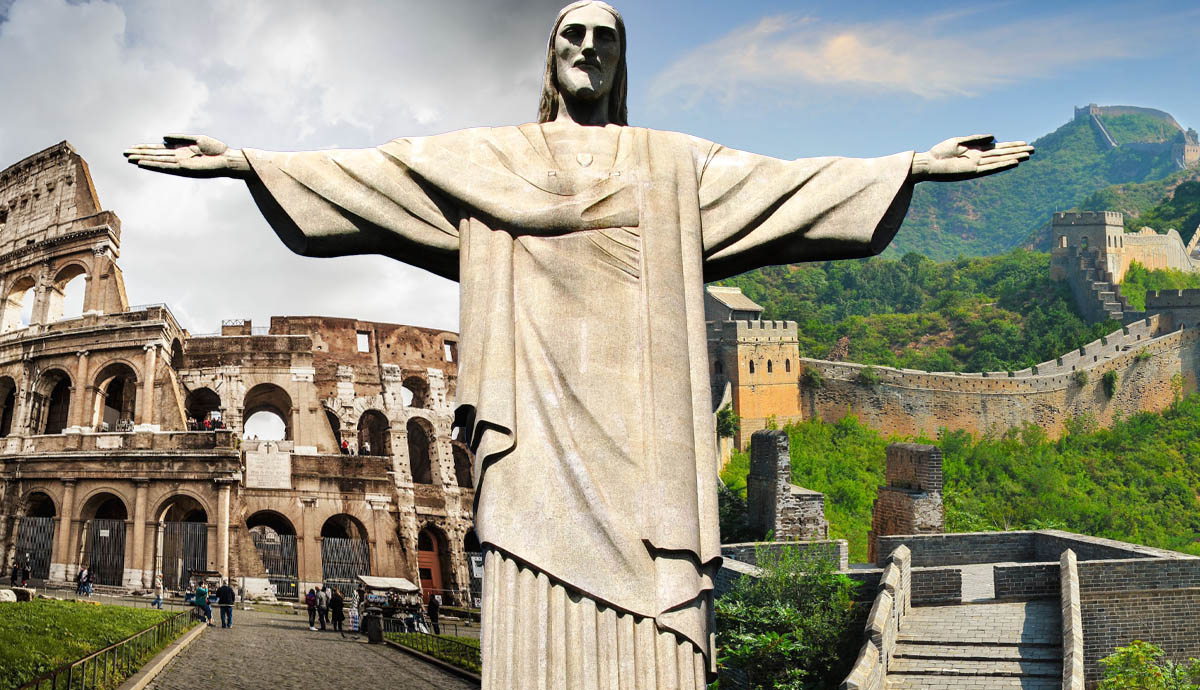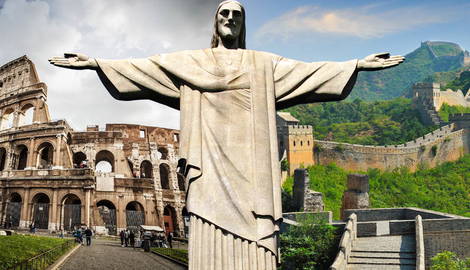
The list of the original seven wonders of the world was made more than 2000 years ago by adventurous Hellenic travelers who marveled at the world’s most incredible man-made constructions. Since then, most of the wonders in the original list have been destroyed, aside from the Great Pyramid of Giza. In 2001, Swiss-born Canadian filmmaker Bernard Weber set up the New7Wonders Foundation to find a new seven wonders of the world for the modern era, asking members of the public to participate in a global vote. After months of deliberating, debating, and shortlists, these are the impressive architectural feats that made the final cut.
1. The Colosseum, Rome, Italy

The Colosseum is the great oval amphitheater in the center of Rome where gladiators once fought for their lives and the pleasure of the crowd. The largest amphitheater ever built, it was constructed from sand and stone over eight years, from 72 to 80 CE. The colossal structure could hold 80,000 spectators, arranged in a circular ring around the central stage. Dramatic and sometimes horrifying events took place here, not just gladiatorial games but also Classical plays, animal hunts, and executions. Some say water was even pumped into the arena to enact mock sea battles known as naumachia.

Although the Colosseum has been partially damaged by earthquakes and stone robbers over the centuries, it is still an iconic testament to Roman history, visited by thousands of tourists every year. Thus, it stands to reason that it would make the list of today’s seven wonders of the world.
2. The Great Wall of China

The Great Wall of China is a huge barrier that spans thousands of miles along China’s historic northern border. Created over millennia, the wall began its life as a series of smaller walls dating back to the 7th century BCE, built as protective barriers against nomadic raids. In 220 BCE, China’s first Emperor, Qin Shi Huang, masterminded the unification of all of China’s walls into one almighty barrier, strengthening and extending the wall to keep out northern invaders.

Today, the Great Wall of China is recognized as one of the seven wonders of the world. Its total length, including all its branches, is a whopping 13,171 miles. While it used to be said that the China Great Wall could be seen from space, astronauts have confirmed that it cannot be seen with the naked eye from the moon.
3. The Taj Mahal, India

India’s renowned Taj Mahal (Persian for Crown of Palaces) is the stunning white marble mausoleum on the bank of the Yamuna River in the city of Agra. It has also been selected as one of the seven wonders of the world. Mughal emperor Shah Jahan built the temple as a tomb for his beloved wife, Mumtaz Mahal, who died during childbirth in 1631. A marble tomb in the center is surrounded by 42 acres of grounds, where gardens, a mosque, a guest house, and a pool complete the complex.
The entire project took over 22 years to complete by 20,000 workers at a cost of 32 million rupees (around US$827 million by today’s standards). But the hard work paid off. Today, the Taj Mahal is recognized as a UNESCO World Heritage Site and a vital component of India’s rich Mughal history.
4. Christ the Redeemer, Brazil

The totemic statue of Christ the Redeemer stands over Rio de Janeiro on the top of Mount Corcovado. At 30 meters tall, this monument is an iconic emblem of Brazil. This huge public artwork was designed by the Polish-French sculptor Paul Landowski in the 1920s and completed by Brazilian engineer Heitor da Silva Costa and French engineer Albert Caquot in 1931. Made from reinforced concrete clad in over six million soapstone tiles, the Christ the Redeemer statue is the largest Art Deco sculpture in the world. Built just after the end of the First World War, the sculpture was an overpowering symbol of Christianity and hope when the world had been brought to its knees.
This is the only monument of the modern world that has made the list of wonders. Other modern world buildings have been suggested as potential wonders, including the Sydney Opera House in Australia; the Eiffel Tower in Paris, France; Beijing National Stadium in China; and Barcelona Pavilion in Spain.
5. Machu Picchu, Peru

Machu Picchu is a lost treasure of the 15th century and a rare citadel discovered high in the Andes mountains above the Peruvian Sacred Valley. Astonishingly, it is one of the only pre-Columbian ruins found nearly intact, featuring evidence of former plazas, temples, agricultural terraces, and homes. Archaeologists believe the citadel was built as an estate for the Inca emperor Pachacuti in around 1450 in polished drystone walls.

The Incas abandoned the site a century later, and it remained hidden for centuries before being brought to public attention by American historian Hiram Bingham in 1911. Because of this remarkable preservation, it is recognized today as one of the seven wonders.
6. Chichén Itzá, Mexico

Deep in the Mexican state of Yucatán lies Chichen Itza, a historic Mayan city built between the 9th and 12th centuries. Constructed by the pre-Columbian Mayan tribe Itzá, the city includes a series of monuments and temples. The most celebrated is El Castillo, also known as the Temple of Kukulcan. It is a huge step pyramid in the center of the city which was built as a devotional temple to the god Kukulkan.

In total, the entire temple features 365 steps, one for each day of the year. Even more impressively, during the spring and summer equinoxes, the afternoon sun casts triangular shadows down the pyramid’s north stairway that resemble a feathered serpent slithering down its surface, heading towards a stone snake head at the base. No wonder it is one of the seven wonders today!
7. Petra, Jordan

Petra, the ancient city in southern Jordan, is also known as the “rose city” for its golden hue. It dates as far back as 312 BCE. Set in a remote valley, this city was founded by the Arab Nabataeans, a sophisticated civilization that carved stunning architecture and complex waterways out of surrounding rock faces. The Nabateans also established Petra as a successful trade hub, earning vast wealth and a booming population before being wiped out by earthquakes.

Unknown to the Western world for centuries, the city was uncovered in 1812 by Swiss explorer Johann Ludwig Burckhardt. The 19th-century poet and scholar John William Burgon described Petra as “a rose-red city half as old as time.”
Map of the Seven Wonders of the World

If you were to visit the seven wonders of the world, it would take you on a journey from Mexico to North America to China’s Great Wall in Asia. The current list of seven wonders takes in much more of the world than the seven wonders of the ancient world, which was very much focused on the Mediterranean.
What Were the Seven Wonders of the Ancient World?

Of course, the new wonders list would never have happened if it weren’t for the original list of the Seven Wonders of the Ancient World. Ancient travelers of the Hellenistic Era made notes on the incredible architectural achievements they encountered along the way, which they believed represented the pinnacle of human imagination and achievement. The new list is paying tribute to this ancient tradition.
Various lists of wonders materialized from their research, but the most celebrated and famous was compiled by Antipater of Sidon (2nd-1st century BCE). His list, put together in poetry form, was as follows: The Great Pyramid of Giza, the Hanging Gardens of Babylon, the Statue of Zeus at Olympia, the Temple of Artemis, the Mausoleum of Halicarnassus, the Colossus of Rhodes, and the Lighthouse of Alexandria. Of this list, the only remaining wonder that is still standing is the Great Pyramid of Giza, completed more than 4,000 years ago. While it might seem arbitrary today, the number seven was of great significance to the ancient Greeks, who saw it as the true embodiment of perfection.
What Are the Seven Natural Wonders of the World?

While the traditional list of ancient wonders focuses on manmade attractions, enthusiasts have also created a list of seven natural wonders. These include Iguazu Falls, which lie on the border between Argentina and Brazil; the Table Mountain in South Africa; Ha Long Bay in Vietnam; the Amazon River and Rainforest; Jeju Island in South Korea; Komodo Island in Indonesia; and Puerto Princesa Subterranean River in the Philippines.
What Were Considered Wonders in the Middle Ages?

Our ancestors in the Middle Ages were also compelled by the great works left behind by their ancestors. While there was no definitive list at this time, from their writings, the 7Wonders Organization has suggested several wonders of the Middle Ages. These include the Hagia Sophia in Istanbul, Turkey; Stonehenge in Wiltshire, England; the Saladin Citadel of Cairo in Egypt; Cluny Abbey in France; Ely Cathedral in Cambridge, England; and the Leaning Tower of Pisa in Italy, among others.







